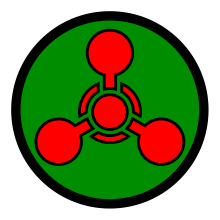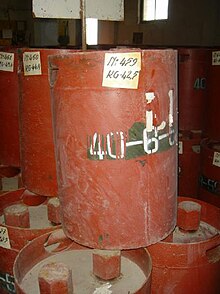
 Pallets of 155 mm artillery shells containing "HD" (mustard gas) at Pueblo Depot Activity (PUDA) chemical weapons storage facility | |
| Blister agents | |
|---|---|
| Phosgene oxime | (CX) |
| Lewisite | (L) |
| Mustard gas (Yperite) | (HD) |
| Nitrogen mustard | (HN) |
| Nerve agents | |
| Tabun | (GA) |
| Sarin | (GB) |
| Soman | (GD) |
| Cyclosarin | (GF) |
| VX | (VX) |
| Blood agents | |
| Cyanogen chloride | (CK) |
| Hydrogen cyanide | (AC) |
| Choking agents | |
| Chloropicrin | (PS) |
| Phosgene | (CG) |
| Diphosgene | (DP) |
| Chlorine | (CI) |
| Vomiting agents | |
| Adamsite | (DM) |
 | |
| Soviet chemical weapons canister from an Albanian stockpile[1] | |
| Part of a series on | |||
| Chemical agents | |||
|---|---|---|---|
| Lethal agents | |||
| Incapacitating agents | |||
|
|||
A chemical weapon (CW) is a specialized munition that uses chemicals formulated to inflict death or harm on humans. According to the Organisation for the Prohibition of Chemical Weapons (OPCW), this can be any chemical compound intended as a weapon "or its precursor that can cause death, injury, temporary incapacitation or sensory irritation through its chemical action. Munitions or other delivery devices designed to deliver chemical weapons, whether filled or unfilled, are also considered weapons themselves."[2]
Chemical weapons are classified as weapons of mass destruction (WMD), though they are distinct from nuclear weapons, biological weapons, and radiological weapons. All may be used in warfare and are known by the military acronym NBC (for nuclear, biological, and chemical warfare). Weapons of mass destruction are distinct from conventional weapons, which are primarily effective due to their explosive, kinetic, or incendiary potential. Chemical weapons can be widely dispersed in gas, liquid and solid forms, and may easily afflict others than the intended targets. Nerve gas, tear gas, and pepper spray are three modern examples of chemical weapons.[3]
Lethal unitary chemical agents and munitions are extremely volatile and they constitute a class of hazardous chemical weapons that have been stockpiled by many nations. Unitary agents are effective on their own and do not require mixing with other agents. The most dangerous of these are nerve agents (GA, GB, GD, and VX) and vesicant (blister) agents, which include formulations of sulfur mustard such as H, HT, and HD. They all are liquids at normal room temperature, but become gaseous when released. Widely used during the World War I, the effects of so-called mustard gas, phosgene gas, and others caused lung searing, blindness, death and maiming.
During World War II the Nazi regime used a commercial hydrogen cyanide blood agent trade-named Zyklon B to commit industrialised genocide against Jews and other targeted populations in large gas chambers.[4] The Holocaust resulted in the largest death toll to chemical weapons in history.[5]
As of 2016[update], CS gas and pepper spray remain in common use for policing and riot control; CS and pepper spray are considered non-lethal weapons. Under the Chemical Weapons Convention (1993), there is a legally binding, worldwide ban on the production, stockpiling, and use of chemical weapons and their precursors. However, large stockpiles of chemical weapons continue to exist, usually justified as a precaution against possible use by an aggressor. Continued storage of these chemical weapons is a hazard, as many of the weapons are now more than 50 years old, raising risks significantly.[6][7]
- ^ Cite error: The named reference
ref1was invoked but never defined (see the help page). - ^ Cite error: The named reference
CWwas invoked but never defined (see the help page). - ^ Vilches, Diego; Alburquerque, Germán; Ramirez-Tagle, Rodrigo (July 2016). "One hundred and one years after a milestone: Modern chemical weapons and World War I". Educación Química. 27 (3): 233–236. doi:10.1016/j.eq.2016.04.004.
- ^ Longerich, Peter (2010). Holocaust: The Nazi Persecution and Murder of the Jews. Oxford; New York: Oxford University Press. ISBN 978-0-19-280436-5.
- ^ From Cooperation to Complicity: Degussa in the Third Reich, Peter Hayes, 2004, pp 2, 272, ISBN 0-521-78227-9
- ^ Blackwood, Milton E (June 1998). "Beyond the Chemical Weapons Stockpile: The Challenge of Non-Stockpile Materiel | Arms Control Association". www.armscontrol.org. Retrieved June 28, 2022.
- ^ Greenberg, M. I.; Sexton, K. J.; Vearrier, D. (February 7, 2016). "Sea-dumped chemical weapons: environmental risk, occupational hazard". Clinical Toxicology. 54 (2): 79–91. doi:10.3109/15563650.2015.1121272. ISSN 1556-3650. PMID 26692048. S2CID 42603071.
